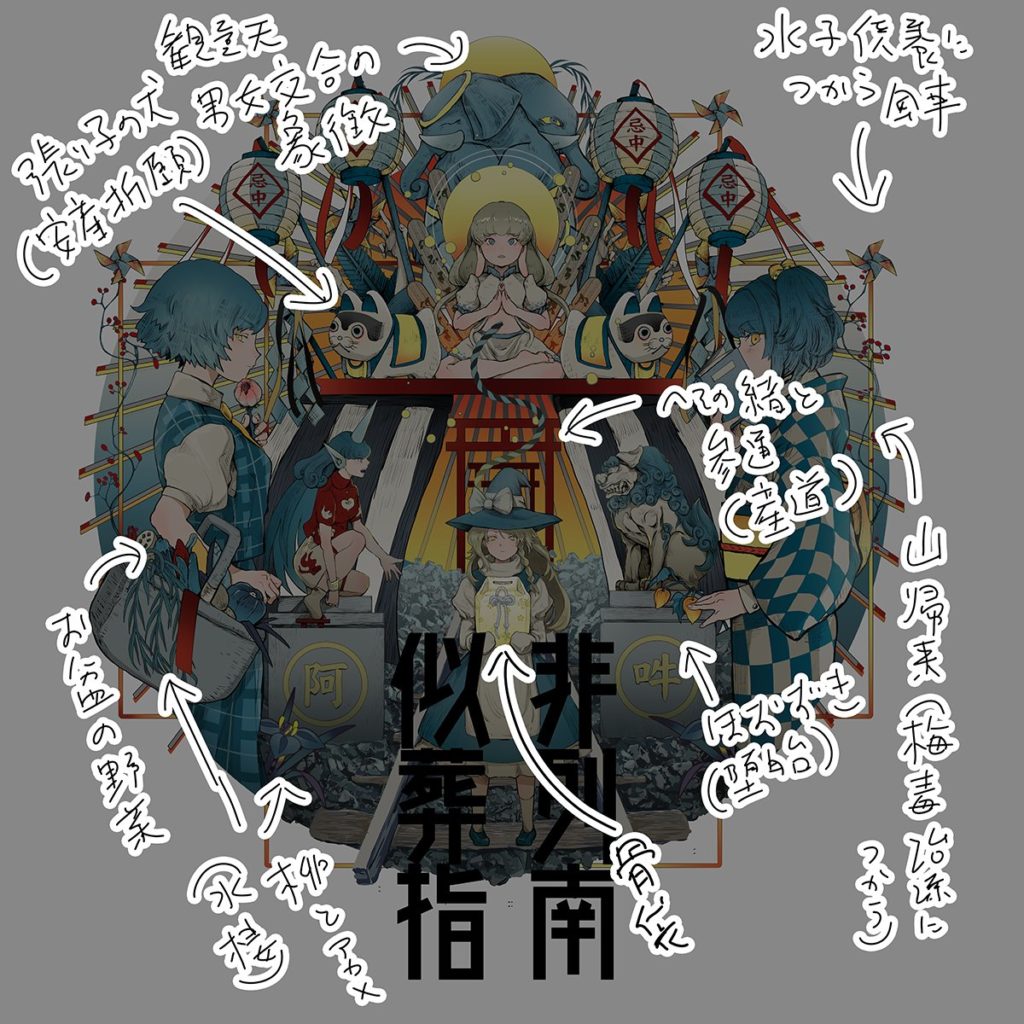Welcome back to the usual review corner! Wow, when was the last time the review title had one single album?
So, as I mentioned in a previous news post, I don’t have my physical copy with me. Due to the coronavirus outbreak, I decided to ship my order to my boyfriend Scott in America. We will probably do the same thing next month, for the Air Comiket albums. Once this pandemic will be over, he will give the albums to me! So, instead of the usual TC Crew picture, have an Animal Crossing screenshot.

There is not a lot to say about the general design. It’s almost the same as Giji Kazoku Nyuumon, with its green and yellow tones, and it’s nice. But the cover art deserves some special mention, as it is full of symbolism related to the theme of birth, rebirth, and unbirth. This attention to the details makes it one of the best album artworks from the Pig. I’ve translated Ranko no Ane’s design commentary from Twitter, and you can read it right after my review! (in true honesty I wouldn’t have got most of this if it wasn’t for her tweets, the cover art was already good without all the deep meaning behind it, now it’s amazing!)
But now, to the music. I’ve taken most of the translated lines from Robin, go check out his blog since he translated all the new tracks from this album!
1. Occultic Dreamer
“Rather than counting to three, open your eyes and check for yourself”
An arrangement of Violet Detector from my favorite group was something I was waiting for since the game’s release. And I’m immensely satisfied with this. It’s such a bright and happy rock song, one of the better tracks for this type of mood! It feels like the “red herring” of this album, and it softens a bit its general mood and theme. Perhaps this is really the Sumireko song that was supposed to be in Magic Lantern (again, this is my supposition, I don’t know Buta’s original plans). “Psycho Teenager” and “Occultic Dreamer” are also quite similar titles!
However, in my heart, it perfectly fits this album. But it’s for personal and very subjective reasons I don’t really want to write here.
2. Karisome Kizuna
“Having something to guard – Everyone has that; it’s not special
Yet this system was arranged to be unnatural”
I really like the general vibe of this track, and how the refrain goes powerful. And we also get a bit of Ranko’s rrrr, wo-hooo! As Aun song, I admit I prefer Karuisome Kizuna (sic, from the booklet) over Mesen.
3. Yukuefumei no. (Souretsu Shinan ver)
“I was, still, a different person
I wasn’t, myself, yet”
A rearrangement of an old favorite of mine from the first Shoujo Rengoku. I honestly thought they forgot about most of the songs from that album, so I’m happy! I really love the intro. This new version is faster than the original song. If this wasn’t a Paprika arrangement I would label it as Groovy…
4. Aoi Ame
“so I can smile again”
Some badass instrumental here! Gotta love the vocal delivery in the verses, too. But if I have a small issue with this album, it is that Comp’s lyrical writing is kind of lazy. A lot of parts in his new lyrics are repeated 2, 3, even 4 times. With this song, in particular, you can make a drinking game and take a sip every time Ranko sings “mata waraeru you ni”. But it’s a small issue that doesn’t stop me from enjoying this track and the others. Too bad there doesn’t seem to be the Sorairo Ribbon connection I was looking forward…
5. Good Meister (Souretsu Shinan ver)
“I’m spinning around… Being popular is hard, isn’t it?”
The original Good Meister is The Marisa Song from BUTAOTOME, and it’s still a supreme song, but I like this Paprilicious take, tho I was a bit perplexed about it during my first listen. It’s not something I would listen outside the album. However, I really appreciate the rearranges in this album not just because the original songs are two favorites of mine, but also because they represent the characters “who are not here now”. This makes them the most clever rearrangements among BUTAOTOME’s discography. The two Touhou protagonists are dead/disappeared/whatever, and these songs represent what we remember of them.
6. Yurikago no Naka de
“You will bloom to be lovely
As you pass through the seasons (time)”
Now, for a fairly unique track! When I was listening to this album with a friend, he was surprised by how it sounded “very electronic for BUTAOTOME”, which makes it stand out more among Comp’s songs here. The original themes have been arranged in a very standard way, with the melody kind of similar to previous Colorful Paths and Flower Lands, but the atypical mix of themes and overall atmosphere truly make up for it.
7. Haikei, Anata no Omoide
“at the end of the whole universe
I’ll be by your side”
The only Paprika track in the album (excluding rearranges). And it’s a great one. The original Bibliophile with the Deciphering Eye is a theme I don’t particularly enjoy, but I’ve been really liking all the BUTAOTOME takes on it. And I love how they all manage to sound different! This gives me the idea for a future article…
8. Toketa Inori
“Disarrayed curtains, shed tears and accumulated prayers melted”
And to end an album about birth, here we have the “unborn”, Eika. The instrumental is some cheerful Comptastic rock with some traditional elements, but Ranko’s tones and the lyrics are somber. It fits its ending spot.
Careful readers have probably noticed how this time I didn’t mention my favorite track of the album, a staple element of all my reviews. It’s simply because while I could easily pick Occultic Dreamer, all the other seven tracks are awesome as well, deserve the love, and form a lovely piece of work together. There are great rock tracks, great Paprilicious moments. great original themes, and a great concept behind everything. Great great great.
So yeah. I love this album. Last time I loved a BUTAOTOME release that much was Daihinmin. While this year didn’t start in the best way, with the coronavirus pandemic that is affecting the doujin world as well, I’m so glad there is such an amazing album to keep us company. #thankyoubutaotome
Ranko no Ane’s design commentary
Original thread. Special thanks to Mme Latence in the Discord server, who deciphered for me Ane’s writing in the picture!
“Ese Souretsu Shinan” is paired with our previous release “Giji Kazoku Nyuumon”.
The blurb is “For you, who were never born
and for me, who will be born.”
It’s structured like a mandala of human birth that can only happen through the union of men and women.

The two elephant heads at the top are Kangiten, a Buddist god that represents sexual intercourse.
The two cat-like things next to Eika are paper-mache dogs, a blessing for a safe pregnancy.
Between Eika and Marisa, there is an umbilical cord and the path to a shrine. The words 参道 (road to a shrine) and 産道 (birth canal) are pronounced the same: sandou.
The pinwheels at the sides are used for mizuko kuyou (Japanese ceremony for miscarriage/abortion).
Around the pinwheels, there are china roots. They are used for syphilis treatments.
Under the komainu statue, there are ground cherries. They are used for abortion.
Yuuka’s vegetable casket represents the Bon Festival, a Japanese summer festivity where they honor the dead.
Around Yuuka, there are a willow and an iris sanguinea.
Marisa is holding an urn.
On the upper right there is “While you do not know life, how can you know about death?”; it’s a Confucius quote. The back cover of the freebies clearfile of the previous album had the temple stamp of the Hakurei Shrine, this time it’s a guide for the wake.
The blurb of “Giji Kazoku Nyuumon”, released at Reitaisai 2017, is “Because nobody taught me that there will be an end, and it will suddenly arrive”, the kanjis on the top right is “virtue (or the man of virtue) is not left to stand alone” and on the back, there is “he who practices it will have neighbors”. It means that people with virtue are never isolated, and always have sympathizers.
Structurally, the two covers are facing each other rather than being made to be put side by side.
As Marisa walks the road, she arrives at the Hakurei Shrine.
Giji Kazoku Nyuumon had ReiMari and Reimu songs as new tracks.
Ese Souretsu Shinan has Eternal Shrine Maiden and Oriental Dark Flight arrangements as rearranged songs.
We wanted to give them the impression of songs about people who are not here now.